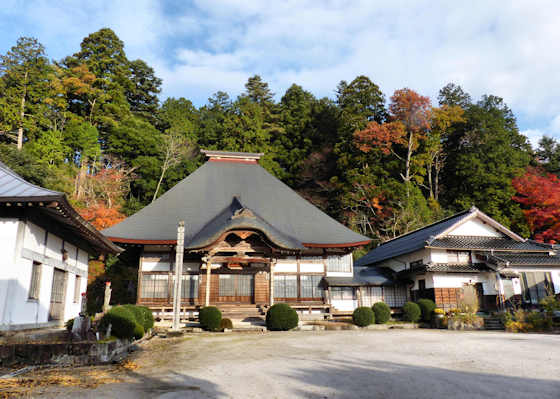Friday, December 6, 2024
Munakata Taisha
Monday, January 30, 2023
Shinsoji Temple Yokota
Shinsoji Temple Yokota
Shinsoji Temple sits on a hillside looking over the town of Yokota on the banks of the Hi River in the Okuizumo region of Shimane.
It does not seem to be a famous temple, and I can actually find almost nothing about it, except we can guess and infer some things.
The buildings and structures have been rebuilt in relatively recent times, and they are substantial, so we can infer that it is a relatively rich temple.
It lies above Igitake Shrine, one of the many shrines in the area connected to the myths of Susano and the Orochi serpent, but between the shrine and the temple is a very large cemetery. There is a good chance that is where the wealth is derived from.
It may also be that the temple looked after and operated the shrine. In historical times there were actually very few Shinto priests, with most shrines being operated by Buddhist priests.
A few things that are known are that the temple belongs to the Soto Zen sect, and the honzon is an Amida.
Wednesday, August 5, 2020
Keishu-en Garden
Keishu-en
Keishi-en is a fairly modern Japanese garden attached to Yoko Museum, a small gallery specializing in Chinese ceramics and art. The garden uses Mifuneyama as "borrowed scenery" behind the garden. It was designed by Kinsaku Nakane whose most well known garden is the one at Adachi Museum in Shimane.
There is a large pond filled with koi, behind which is a karesansui garden with many azalea bushes which bloom in the late spring. Unusually the upper part of the garden is a tea plantation with rows of tea plants following the contours.
The path around the garden passes over a bridge by a small waterfall and also leads to a teahouse where you can get traditional tea and sweets.
Most visitors to the area visit the Mifuneyama Rakuen Garden which is very close by and also uses Mifuneyama as a backdrop, but Keishu-en is well worth a visit, especially if you appreciate the work of Kinsaku Nakane
Sunday, June 28, 2020
Shikoku Pilgrimage Temple 39 Enkoji
I arrived at Enkoji, temple 39 on the Ohenro pilgrimage, on December 26th. It had taken a couple of days to walk from the previous temple at the cape. I had chosen a slightly longer route along the coast rather than backtracking and then going over the mountains. Even down at sea level it had snowed some yesterday, Christmas Day.
Enhoji has a fine pair of Nio in the main gate. Reputed to be founded in 724 by the renowned monk Gyoki, like many of the other temples on the Ohenro pilgrimage The honzon is yakushi Nyorai, reputedly carved by Gyoki.
.
A well in the grounds is famous for healing eye problems, and there is also a statue of a turtle relating to a legend of a giant turtle with a red bell on its back visiting the temple in 901. I was rather taken by the carvings however.
There are a couple of small gardens and in one a pond filled with koi.
Friday, September 6, 2013
Aiba Waterway Koi
The carp-filled Aiba waterway runs through a quiet neighborhood in the southern section of Hagi.
Originally a stream, it was canalized to prevent flooding and to provide irrigation to paddies. It was later widened and deepened to enable small boats to be used for transporting materials.
Houses along the waterway built "hatoba", allowing the water of the canal to come into the kitchens and bathrooms where it could be used without having to go outside.
Several of the houses are open to the public including the childhood home of Taro Katsura, Japans' longest serving Prime Minister.
Saturday, June 25, 2011
Manhole Fish
This is the manhole cover for Nishinoshima, one of the islands that make up the Oki Islands. I know a squid is not a fish, but its close enough.
Masuda down in the southwest of Shimane has the Takatsu River and I'm guessing these are carp.
This is from Taki Town up in Izumo and its hard to tell from the design exactly which fish it is meant to be, could be flying fish or it could be an Orca.
Fukuura is a village on the Shimane Peninsular and now a part of Mihonoseki. The fish is probably a Sea Bream (tai) as Kotoshironushi, popularly known as Ebisu, used to enjoy fishing for Tai here.
The draincover for Mihonoseki also features the Tai.
Another one from Masuda, and these look like Ayu, called Sweetfish in English. The Takatsu River is a popular place fro Ayu fishing.
Not sure which town this belongs to, but it was on the banks of the Shimanto River in Ehime, Shikoku. They might also be Ayu.
Sunday, February 6, 2011
Nagashibina Doll Museum
This is the draincover for Mochigase Town, now part of Tottori City.
It shows the Nagashibina Doll Museum which houses a collection of over 1,000 Hina dolls of the Edo period from all over Japan.
Mochigase Town is one of the few places in Japan that still practises the rituals at the heart of the Hina Matsuri.
There is a nice little garden and pond within the grounds
With the obligatory hungry koi!!!
The building itself is an unusual example of a large wooden building built in the traditional style.
Saturday, August 7, 2010
A detailed view of Korakuen
Korakuen in Okayama City is one of the three top ranked gardens in Japan.
Before posting some shots of the garden, I thought I would show some of the details that attracted my eye. If you like koi, more posts here.
I also posted some shots of lotus blossoms from Korakuen earlier.
I posted a sequence of red umbrellas at Matsuo shrine earlier.









































